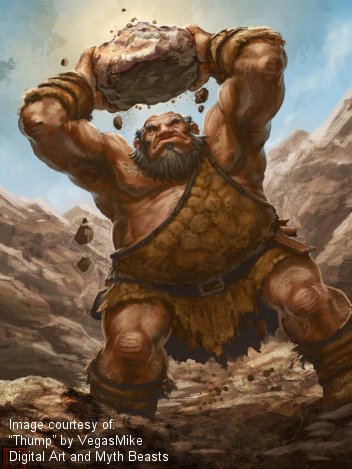Jock o’ Bennachie
 Extracted from the Book “Bennachie” by Alex Inkson McConnochie
Extracted from the Book “Bennachie” by Alex Inkson McConnochie
According to tradition, Bennachie of old was guarded by a giant, known by the name of Jock o’ Bennachie. Jock’s dimensions were somewhat enormous, as may be understood from the extent of ground which he required for his bed. The bed is still shown and is known as “Little John’s Length”, Jock despite his exceptional height, being familiarly styled “Little Johnnie”. Little John’s length, as already stated, is situated to the east of Craig Shannoch and is the space between two small craigs. One of these craigs is about 1,440 feet and the other about 1,400 feet above sea level. The distance between them is about 600 feet, so Jock must have been tall, even for a giant.
Jock seems to have required all his huge proportions to combat with his foes, who were both powerful and numerous, his principal opponent being Jock o’ Noth. Noth is a well-known hill in the parish of Rhynie, 13 miles to the north-west of Bennachie. The distance did not seem to prevent a frequent exchange of compliments, in the shape of huge boulders, between the two. On Tap o’ Noth, it is said, may yet be seen a stone with the mark of five gigantic fingers thereon which, according to popular tradition, was thrown by Jock o’ Bennachie from Oxen Craig at Jock o’ Noth. The latter, on this particular occasion, retaliated by raising a huge mass of rock with a view to hurling it to the mountain of the Garioch, when Jock o’ Bennachie put out his foot , just touching the mass. The result was that it never left Tap o’ Noth and indeed, if you care to look, you will find the mark of Jock’s toe thereon!
Jock has been accused of throwing stones at the priest of Kemnay – a man of great piety, as Cadenhead’s ballad tells. Of course, this is a mistake, Jock, like most other big men, was of a peaceful, not to say kindly disposition. Another tale tells of a more likely culprit as being the “aul Smith”, the Devil.
There are several large granite boulders near Kemnay, a particular one being on land at Wellbush as well as another on the farm of Greatstone, which accounts for the name (Greatstone Farm is now known as Boatleys Farm). The principal stones being of the following dimensions: 20 x 12 x 7 feet, 21 x 16 x 8 feet and the Devil’s Stone or Deil’s Stane, 20 feet on the incline, 10 feet perpendicular depth, 60 feet in circumference at 3 feet above the ground and at 5 feet up 42 feet. These stones were popularly believed to have been hurled by the “aul Smith”, from the top of Bennachie at the priest of Kemnay. The priest was particularly active against Satan and all his works.
As mentioned earlier, Jock o’ Bennachie was blamed for throwing these stones as a pastime while not more seriously engaged with his brother Jock o’ Noth, but the enemy of mankind ought to get the credit if they were thrown from the Mither Tap. The aforementioned Deil’s stane has historically been known as the Grey Stone and the field in which it lies was known as Greystone Bank. The Greystone, as it is now named on the Ordnance Survey map, is now a central feature in Bogbeth housing development, in which one of the roads bears the same name.
Returning to Jock, he succeeded in defending himself against his visible foes but had ultimately to succumb to enchantment and is buried in a cave somewhere on the mountain that he was wont to guard. However, let it be understood, Jock is not dead – he is merely under a spell, secured by lock and key. Of course the key is lost but one version of a prophecy says:
A wife’s ae sin wi’ ae e’e
Sall fin’ the key o’ Bennachie
Translation:
A wife’s one son with one eye
Shall find the key o’ Bennachie
… and then the giant will be freed. The prophecy remains unfulfilled however : the key has not yet been found and poor Jock lies spell-bound in his unknown cave on Bennachie, where once he ruled supreme.
(Ballads to follow)
